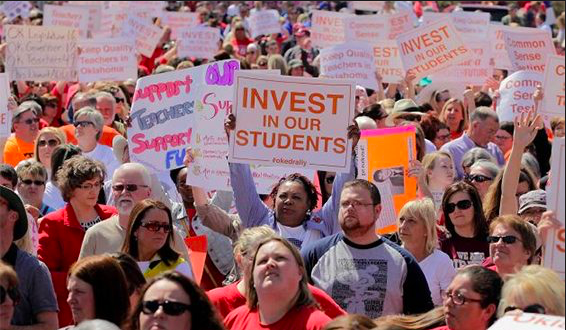Teachers strikes often generate headlines where they’re taking place, but their influence can extend beyond local communities and affect political discourse in surprising ways, according to a new study by Brown University’s Melissa Arnold Lyon and Matthew A. Kraft. The researchers looked at 550 local strikes in the past few years, some of them part of the coordinated “Red for Ed” work stoppages in 2018, and the political advertisements that followed them. FutureEd associate director Phyllis Jordan spoke with Lyon about the new research.
You’ve looked at the connection between teacher strikes and political ads for Congressional candidates. What did you find?
We found that strikes dramatically increase the prevalence of education mentions in political ads, and we found that the increases are almost exclusively in positive ads.
How do you decide whether an ad is negative or positive?
We do that in two ways. We look at ads promoting versus attacking a candidate and we consider the music in the background, whether the tone of the music playing is upbeat or whether it’s ominous or tense or melancholy. Positive ads promote candidates or have an upbeat tone.
Can you tell me more about that?
There are about 450,000 education ads in our dataset. It’s a dataset that’s used in political science literature mostly, and a set of professional coders had already coded the ads based on several different dimensions. One dimension was whether the ad promoted a candidate or attacked an opposing candidate. For example, one positive ad in the Sacramento media market in 2016 after a teacher strike shows a teacher explaining her support for a candidate in Spanish. She explains that she supports the candidate because he fights to empower teachers and increase education spending.
We were interested in this because we thought that teacher strikes could create a backlash in which Republican candidates who didn’t feel like they had much to gain from aligning with the teachers’ union might use strikes as opportunities to attack opposing candidates for pandering to unions at the expense of parents and students.
But that’s not what we found. We found that the increase in ads mentioning education was primarily an increase in positive ads, not attacks.
We tend to think of teacher strikes as local efforts to get better working conditions or pay. Are you suggesting they also convey a broader message about the importance of education?
Yes, that’s an effect of the strikes. By creating these dramatic spectacles, strikes are attracting attention to education in a way that’s elevating education as a political priority. Though the U.S. House of Representatives doesn’t impact local education decision-making directly, we found that the strikes were nonetheless prompting candidates to show that education was a priority issue for them.
Why did you choose political ads as a way to measure the impact of strikes?
First, it’s an established measure of political discourse. Some people have asked, “Why didn’t you look at long-term election outcomes?” That’s something that we plan to do in the future, but we’re really interested in political discourse in and of itself because we think that the discourse matters. It shapes how we think about education, and how we think about education shapes the problems that we think we need to fix and the policy solutions that are on the table.
Second, political ads give us a unique window into what issues are resonating in political discourse because ad are costly. The average 30-second spot we studied cost $550. But some are as much as $250,000. And they’re also high stakes because they’re public declarations of a candidate’s agenda. And political scientists have found that ads are consequential for voter behavior, election turnout, and candidate’s future legislative agendas.
Do strikes yield more positive ads in certain types of communities?
We looked at three different political contexts based on partisan affiliation, because of the historic and long-standing relationship between teachers’ unions and the Democratic Party. We looked at Democratic-dominant districts, Republican-dominant districts, and battleground districts, where there had been contested elections. We found that the increase in education mentions is way bigger in places that are political battleground areas. A strike leads to a 130 percent increase in the probability of airing an education ad overall. But in political battleground areas, it’s actually an increase of over 350 percent.
Does a longer strike lead to more mentions or is a shorter strike just as effective?
We found that short strikes—a week or less—produced big impacts on political discourse and elevated education as a priority; long strikes had no effect. Surprisingly, perhaps, long strikes don’t prompt negative ads.
Going forward, what should teacher unions and policymakers draw from this research?
Past research has not fully considered that strikes may have an impact outside of the demands that teachers are making. Strikes sometimes fail to achieve the demands that teachers and their unions are pursuing, and that was certainly the case in many of the statewide strikes in 2018. But even when they don’t achieve those wins, they can still have broader impacts on the way we think about and understand education and the way that we talk about education in political dialogue.
That’s not to say that teachers should all start striking and that even if they don’t get what they’re asking for they’re going to get positive media attention and positive political attention for themselves and for public education. There’s a realistic possibility that if teacher strikes continue to increase as they have in the past few years, the positive attention to education that has flowed from them might not be as forthcoming. We found that the first strike in a given district is the most impactful; after that, the impact of strikes on political discourse declines.
